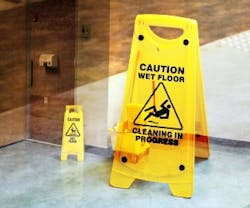Best Practices for Efficient Washroom Maintenance
It’s tough to stay on top of faucet function and frequent restroom cleaning, but investing in smart measurement, monitoring and inspection tools can make the task easier and conserve resources.
Streamline your restroom maintenance and cut down on waste with these tools and tactics.
Amenity Alerts
Inspection and refill tools help busy FMs monitor washroom supplies and cleanings without having to stop by in person. New IoT-enabled dispensers use embedded sensors to track and predict when refills are needed, allowing FMs to plan restroom maintenance more efficiently. For cleaning carts or storage spaces, Cintas recommends chemical dispensing systems that release a controlled amount of cleaning solution, which helps reduce waste and ensures that employees use proper proportions to dilute concentrated chemicals.
Inspections can also benefit from easy-to-use technology. One subscription service logs restroom checks, cleaning visits and repair tickets with a red or green indicator that allows users to see whether a room has been serviced on schedule. Customers use anonymous texts to submit feedback if anything is broken or a refill is needed, allowing you to keep track of trends in complaints received for certain areas, restrooms or staff members.
Alternatively, hygiene monitors also measure cleaning frequency; facilities personnel log in with a smart card when they show up to clean the restroom, which resets a timer that counts down to the next inspection. Some models offer options for customer ratings, such as texting or push-button cleanliness options on the front of the wall-mounted monitor.
Water Watching
Submetering water use is a great way to understand your facility’s water consumption in general, though it won’t help you understand the consumption patterns of individual restroom fixtures. The EPA recommends submetering any system expected to use more than 1,000 gallons a day or 100,000 gallons per year, including any alternative water sources like graywater or rainwater capture – this will at least help you identify higher-than-expected consumption that could indicate leaks and measure the impact of conservation strategies.
Smaller buildings can benefit from positive displacement meters, which maintain accuracy at low flow rates while measuring peak flows precisely. Compound meters use a multiple-measuring chamber design for both high and low flows, making them a good choice for larger facilities. Whichever one you choose, make sure you pick the appropriate size based on your building’s size, function, fixture types, usage and peak population and install it in an accessible location away from pipe bends. Map the placement of each one so you can collect regular readings when you make your facility rounds and try to conduct readings during off-peak hours when equipment is turned off and no one is using the restroom, the EPA suggests.
Best Practices
The success of your strategy depends on your willingness to monitor your new tools and look for trends in the data. Consider these three tips on optimizing your restroom maintenance:
1) Pay attention to time trends and usage patterns. Examine your apps, sensors or automated inspection logs and look for common threads. Does a certain restroom or floor tend to need an extra hand towel refill at a certain point in the day? Anticipate that need and plan to swing by that restroom while you’re doing other work in the area to avoid making an extra trip. Building efficiency into your regular routine starts with gathering data.
2) Establish a user-friendly reporting method for leaks and refill requirements. If your monitoring tools don’t have this capability built in, create another pathway for people to let you know that some stalls are out of toilet paper or the sink keeps dripping. You’ll be able to address problems quickly, and the timing of these alerts will help you develop a better schedule for refills and other maintenance.
3) Don’t forget preventive maintenance. Automated maintenance gadgets can help with many tasks, but they can’t test your toilet’s piston valves or inspect your faucet aerators for scale buildup. As you revamp your maintenance schedule based on the data gathered by your new tools and practices, make sure preventive tasks remain in place.
